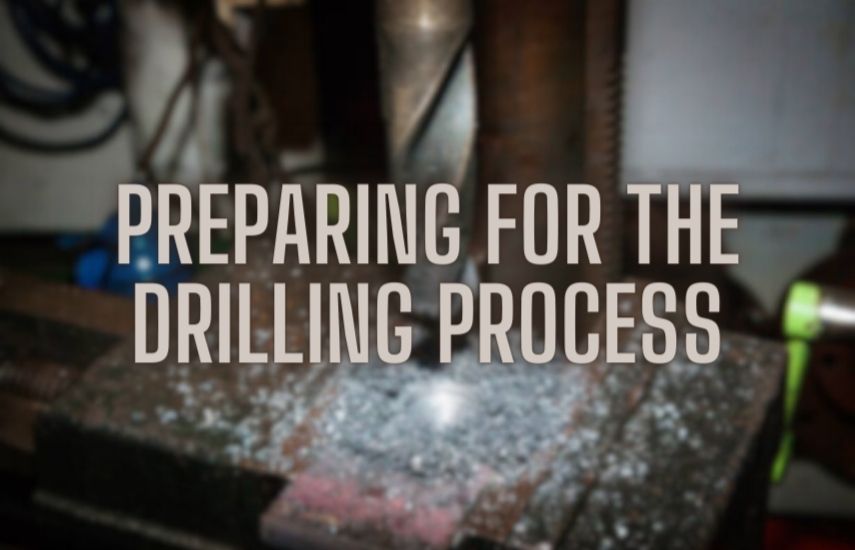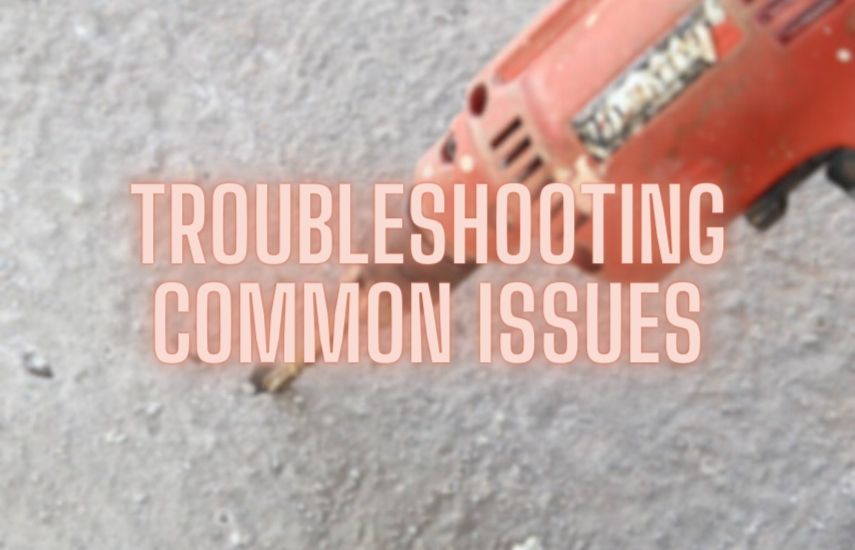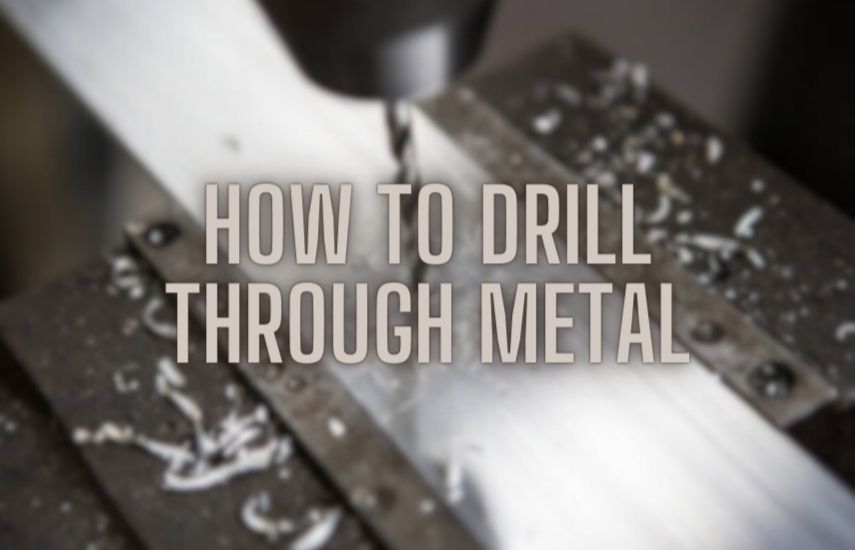Metal drilling is a task that requires precision, patience, and the right tools. Whether you’re a DIY enthusiast or a professional metalworker, drilling through metal can be a daunting task.
How To Drill Through Metal? To drill through metal, start by selecting the appropriate drill bit based on the type of metal you’re working with. Use a center punch to mark the spot you want to drill, then slowly and steadily drill at a low speed, applying light pressure. Use cutting oil to lubricate the bit and cool the metal.
Many people ask the question “how to drill through metal?” because they want to ensure that they do it right the first time. From creating holes for electrical wiring to making modifications to metal structures, drilling through metal is a crucial skill. In this blog, we will provide you with some expert tips and tricks on how to drill through metal like a pro.
Necessary Tools and Equipment
Drilling through metal can be a challenging task if you don’t have the right tools and equipment. We will discuss the necessary tools and equipment that you need to have before you start drilling through metal. With the right tools and equipment, you can make the process much easier and ensure a successful outcome.
Choosing the right drill bits for metal
Choosing the right drill bit for metal is crucial for achieving a clean and precise hole. When selecting drill bits for metal, there are a few important factors to consider. Firstly, the material of the drill bit is essential. High-speed steel (HSS) drill bits are suitable for drilling through most metals, while cobalt drill bits are better suited for harder metals such as stainless steel.
Secondly, the size of the drill bit is important. Using a smaller drill bit for pilot holes can make it easier to drill larger holes later. Lastly, the shape of the drill bit can affect the outcome of the hole. Twist bits are the most common type of drill bits used for drilling through metal.
Power drills and drill presses
A power drill or drill press is essential for drilling through metal. Power drills are handheld and are suitable for smaller projects. Drill presses, on the other hand, are more powerful and are better suited for drilling larger holes or through thicker metal.
When choosing a power drill or drill press, it’s important to consider the power, speed, and torque of the tool. A high-powered tool with variable speed settings and a high torque can make drilling through metal much easier.
Lubricants and cutting fluids
Using a lubricant or cutting fluid can make drilling through metal much easier and reduce the risk of damage to the drill bit or the metal. Lubricants and cutting fluids can help to cool the drill bit and reduce friction, which can prevent the bit from overheating and becoming damaged.
They can also help to remove metal shavings from the hole and reduce the risk of the bit becoming stuck in the metal. Common lubricants and cutting fluids include motor oil, mineral oil, and cutting oil.
Safety gear and precautions
When drilling through metal, it’s essential to wear the appropriate safety gear and take necessary precautions to prevent injury. Safety glasses or goggles should be worn to protect the eyes from metal shavings and debris. Gloves should also be worn to protect the hands from sharp edges and hot metal. A dust mask or respirator can be worn to prevent inhaling metal dust or fumes.
It’s also important to secure the metal properly to prevent it from slipping or moving while drilling. Lastly, make sure to follow proper drilling techniques and avoid forcing the drill through the metal, as this can damage the drill bit or the metal.
Preparing for the Drilling Process

Before drilling through metal, it is essential to properly prepare the workpiece and tools to ensure a successful outcome. This includes marking the drilling location, creating a pilot hole or center punch, and securing the metal workpiece. We will delve deeper into each of these crucial preparation steps.
Marking the drilling location
The first step in preparing for the drilling process is to mark the drilling location on the metal workpiece. This can be done using a center punch or a scriber. A center punch is a pointed tool that is used to make an indentation in the metal, which serves as a guide for the drill bit. A scriber is a sharp tool that is used to scratch a line on the metal, indicating the exact location for the drill bit.
When marking the drilling location, it is important to ensure that the mark is visible and accurate. The mark should be made on the surface of the metal workpiece that will be drilled, and it should be clear and easy to see. The mark should be located in the center of the drilling spot, as this will help to prevent the drill bit from wandering during the drilling process.
Creating a pilot hole or center punch
Once the drilling location has been marked, the next step is to create a pilot hole or center punch. This step is essential, as it helps to guide the drill bit and prevent it from wandering off course.
A pilot hole is a small hole that is drilled into the metal workpiece before the larger hole is drilled. This hole serves as a guide for the drill bit and helps to ensure that the larger hole is drilled in the correct location. The size of the pilot hole should be slightly smaller than the diameter of the drill bit that will be used for the larger hole.
Alternatively, a center punch can be used to create an indentation in the metal workpiece, which serves as a guide for the drill bit. This indentation can be made using a center punch, as mentioned earlier, or it can be made using a hammer and nail.
Securing the metal workpiece
The final step in preparing for the drilling process is to secure the metal workpiece. This is important because it helps to prevent the workpiece from moving during the drilling process, which can cause the drill bit to wander off course. There are several ways to secure a metal workpiece, depending on the size and shape of the workpiece.
One common method is to use a vise to hold the workpiece in place. A vise is a mechanical device that clamps onto the workpiece, holding it securely in place. Alternatively, a C-clamp or a clamp-on vise can be used to secure the workpiece to a stable surface. It is important to ensure that the workpiece is held firmly in place and cannot move during the drilling process.
Drilling Through Metal
Drilling through metal may seem like a daunting task, but with the right tools and techniques, it can be done with ease. We will walk you through the step-by-step process of drilling through metal, including selecting the appropriate drill bit size and type, applying cutting fluid or lubricant, starting the drilling process, adjusting drill speed and pressure, monitoring progress and adding more lubricant, clearing away metal shavings, finishing the hole, and deburring.
Selecting the appropriate drill bit size and type
The first step in drilling through metal is to select the appropriate drill bit size and type. When it comes to drilling through metal, you’ll want to choose a drill bit made of high-speed steel (HSS) or cobalt. These types of bits are specifically designed to withstand the heat and pressure that comes with drilling through metal.
You’ll also want to consider the size of the hole you need to drill and select a drill bit that matches that size. It’s important to note that the larger the drill bit, the slower you should drill to avoid overheating and breaking the bit.
Applying cutting fluid or lubricant
Before you begin drilling, it’s important to apply cutting fluid or lubricant to the surface of the metal. This will help to reduce heat and friction, which can cause the drill bit to become dull or even break. You can use a variety of lubricants, including oil, water, or a specialized cutting fluid designed for metal. Be sure to apply the lubricant generously, and periodically add more as you drill to keep the bit cool and lubricated.
Starting the drilling process
Once you have selected the appropriate drill bit and applied the cutting fluid or lubricant, it’s time to start drilling. Position the drill bit at the spot where you want to drill the hole and make sure it is perpendicular to the surface of the metal. Start drilling slowly, applying even pressure to the drill. Avoid applying too much pressure, as this can cause the drill bit to break or become stuck in the metal.
Adjusting drill speed and pressure
As you continue drilling through the metal, you may need to adjust the speed and pressure of the drill. If the drill starts to slow down or become stuck, you may need to increase the speed or pressure. However, be careful not to apply too much pressure, as this can cause the drill bit to break or become stuck in the metal. If you notice smoke or excessive heat, stop drilling and let the metal cool down before continuing.
Monitoring progress and adding more lubricant
As you drill through the metal, it’s important to monitor your progress and add more lubricant as needed. Check the drill bit periodically to make sure it is still sharp and hasn’t become too hot. If the drill bit becomes dull or starts to overheat, stop drilling and allow it to cool down before continuing.
Clearing away metal shavings
As you drill through the metal, metal shavings will accumulate around the hole. To prevent these shavings from damaging the surface of the metal or getting in the way of your drilling, you should clear them away periodically. You can use a brush or compressed air to clear away the shavings, or you can stop drilling and remove them manually.
Finishing the hole and deburring
Once you have drilled through the metal, you can finish the hole by using a deburring tool to smooth out any rough edges or burrs. This will help to ensure that the hole is clean and smooth, which is important if you plan to use the hole for any purpose. Be sure to clean up any remaining metal shavings and wipe down the surface of
Troubleshooting Common Issues

Drilling through metal can be a challenging task, especially if you’re not equipped with the right tools or knowledge. Even if you have the best drill bits and the most powerful drill, you may still encounter some common issues that can impede your progress.
Dealing with a Broken Drill Bit
Breaking a drill bit while drilling through metal can be frustrating and time-consuming. It can also be dangerous if you’re not careful. The good news is that it’s a common problem, and there are several ways to deal with it.
The first thing you should do is stop drilling immediately. Continuing to drill with a broken bit can cause serious damage to your drill and may even cause injury. Once you’ve stopped, assess the situation to see if you can remove the broken bit from the metal. If it’s stuck, you may need to use pliers or a pair of vice grips to loosen it.
If you can’t remove the bit, you’ll need to replace it with a new one. Before you do, make sure you clean any debris or metal shavings from the drill and the hole you were drilling. This will help prevent any further damage to your drill and ensure that the new bit doesn’t get stuck or break.
Addressing Overheating and Bit Dulling
Overheating and bit dulling are two common problems that can occur when drilling through metal. Overheating can cause your bit to become dull, which can make it harder to drill through the metal. It can also cause the metal to warp or become damaged.
To prevent overheating, make sure you’re using the right type of drill bit for the metal you’re drilling. Some metals, like stainless steel, require special drill bits that can handle high temperatures. You should also use cutting fluid to lubricate the bit and cool down the metal as you drill.
If your bit does become dull, you can sharpen it using a sharpening stone or a drill bit sharpener. Just make sure you follow the manufacturer’s instructions and take your time. Sharpening a bit incorrectly can cause it to become even duller or break.
Fixing Uneven or Misaligned Holes
Uneven or misaligned holes can be a frustrating problem, especially if you’re trying to create a precise hole for a specific purpose. The good news is that there are several ways to fix this problem.
One way to fix uneven holes is to use a reamer. A reamer is a tool that can help you enlarge and straighten out a hole that’s slightly off-center or crooked. You can also use a center punch or a drill press to create a new hole in the correct location.
To prevent misaligned holes in the future, make sure you mark the center of the hole before you start drilling. You should also use a drill press or a guide to ensure that your drill is straight and aligned with the center mark. This will help you create a precise and accurate hole every time.
Maintenance and Care for Tools
When it comes to drilling through metal, having properly maintained and cared for tools is crucial. Not only will it ensure that your tools work effectively and efficiently, but it can also help extend the lifespan of your equipment. We will discuss some essential maintenance and care tips to keep your tools in tip-top shape.
Proper cleaning and storage of drill bits
One of the most important steps in maintaining your drill bits is to ensure they are cleaned and stored correctly. After each use, it is essential to clean off any debris or residue that may have accumulated on the drill bit. This can be done by wiping the bit with a clean cloth or using a wire brush to remove any stubborn debris.
Once the drill bit is clean, it should be stored in a dry and cool place to prevent any rust or corrosion from forming. You can use a designated drill bit storage case or simply wrap them in a cloth and store them in a toolbox.
Inspecting and replacing worn tools
Inspecting your tools regularly is crucial to ensure that they are in good working condition. When using your drill, keep an eye out for signs of wear and tear, such as chipping or dullness on the drill bit. If you notice any signs of damage, it’s time to replace the tool immediately.
It’s important to inspect your drill’s other components, such as the chuck and motor, to ensure they are working correctly. Regular inspections can help prevent unexpected breakdowns and prolong the lifespan of your tools.
Sharpening drill bits for extended use
Over time, drill bits can become dull and less effective, making it difficult to drill through metal. To combat this issue, it’s essential to sharpen your drill bits regularly. There are several ways to sharpen drill bits, including using a drill bit sharpener, a bench grinder, or a sharpening stone.
When sharpening your drill bits, it’s important to ensure that the bit is sharpened at the correct angle. Different materials require different angles, so make sure to do your research before attempting to sharpen your bits. Sharpening your drill bits can help extend their lifespan and save you money in the long run.
Proper maintenance and care are essential to keep your drilling tools in good working condition. By following these tips for cleaning, inspecting, and sharpening your tools, you can ensure that they work effectively and efficiently, and last for years to come.
Conclusion (How To Drill Through Metal)
Drilling through metal requires the right tools and technique. Choose the right drill bit and use a center punch to mark your spot. Drill slowly and steadily, using cutting oil to keep the bit lubricated and the metal cool. Apply light pressure and avoid overheating the bit.
In conclusion, drilling through metal requires careful consideration of various factors such as the type of metal, the size and thickness of the material, and the drilling equipment to be used. Throughout this article, we have explored key techniques and best practices that will ensure successful metal drilling. We have also discussed the importance of using the right cutting tools, lubricants, and drill bits to achieve precise and clean cuts.
As you become more experienced in metal drilling, you may want to explore advanced techniques and equipment to improve your efficiency and productivity. Some of these techniques may include using carbide-tipped drill bits, high-speed steel drills, and coolant systems. You may consider investing in specialized drilling machines such as magnetic drills or drill presses for more demanding metal drilling projects.









